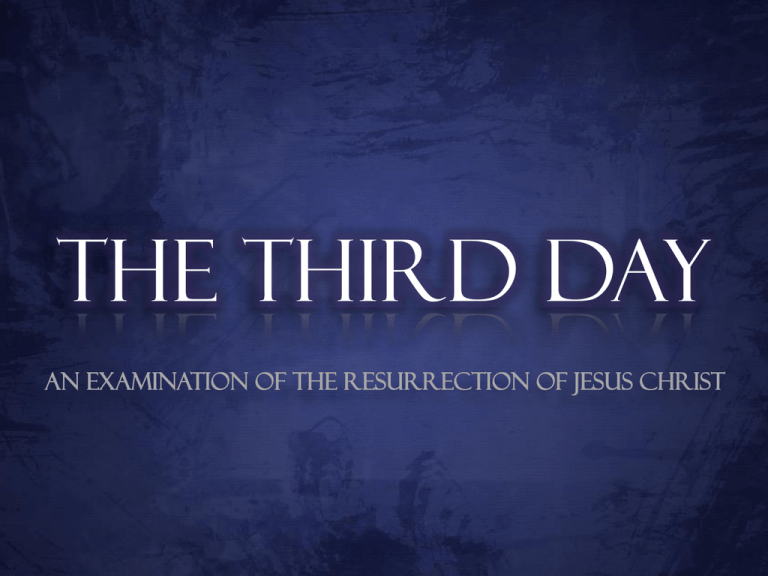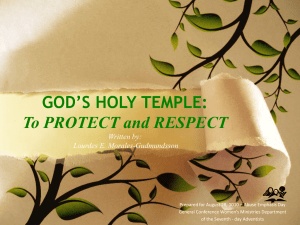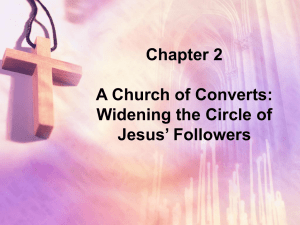Get the Powerpoint presentation
advertisement

The Third Day An Examination of the Resurrection of Jesus Christ The Third Day The Death of Jesus – Part 2 The Darkness at the Crucifixion “It was now about the sixth hour, and darkness fell over the whole land until the ninth hour, because the sun was obscured” (Luke 23:44–45) The Darkness Referred to in History "Now Phlegon, in the thirteenth or fourteenth book, I think, of his Chronicles, not only ascribed to Jesus a knowledge of future events . . . but also testified that the result corresponded to His predictions. . . . And with regard to the eclipse in the time of Tiberius Caesar, in whose reign Jesus appears to have been crucified, and the great earthquakes which then took place . . . " Origen Against Celsus XIV "Phlegon records that, in the time of Tiberius Cæsar, at full moon, there was a full eclipse of the sun from the sixth hour to the ninth - manifestly that one of which we speak.” – Julius Africanus, XVIII God Visits in Darkness “Darkness symbolizes divine wrath. This kind of pitch blackness, more severe than the darkness that occurred in the covenant with Abraham. More severe than the darkness that occurred at Sinai. This is Day of the Lord darkness. This is that final darkness. What does it symbolize? The presence of God in judgment. And that’s why I say there’s a new actor on the stage, that the main character is now God and He has taken center stage. God arrived at Calvary not in light but in darkness. He showed up to unleash judgment Not in the eschatological sense in the future, against the ungodly, but in the soteriological sense against the godly One. . . . What’s happening here is divine wrath is being poured out in its final form. Eternal wrath is about to be released and the darkness is everywhere. You could say it another way. God brought hell to Jerusalem that day.” – John MacArthur “You know that He appeared in order to take away sins; and in Him there is no sin. ” (1 John 3:5) Three Hours of Darkness “It was now about the sixth hour, and darkness fell over the whole land until the ninth hour, because the sun was obscured” (Luke 23:44–45) The number three in Scripture typically stands for divine fullness or perfection as well as approval and completeness. Separation from the Father “About the ninth hour Jesus cried out with a loud voice, saying, “Eli, Eli, lama sabachthani?” that is, “My God, My God, why have You forsaken Me?” ” (Matthew 27:46) “My God, my God, why have You forsaken me?” (Psalm 22:1) Separation from the Father “He made Him who knew no sin to be sin on our behalf, so that we might become the righteousness of God in Him. ” (2 Corinthians 5:21) Jesus, at that moment – the end of God’s visitation of judgment – was experiencing the abandonment and despair that resulted from the outpouring of divine wrath on him as the sin-bearer. The Death of Jesus Christ Between 3 and 5pm is the time when the Passover lambs were typically killed and this is when Jesus dies – just after 3pm. ““No one has taken it away from Me, but I lay it down on My own initiative. I have authority to lay it down, and I have authority to take it up again. This commandment I received from My Father.” ” (John 10:18) The Death of Jesus Christ “Therefore when Jesus had received the sour wine, He said, “It is finished!” And He bowed His head and gave up His spirit. ” (John 19:30) “finished” = ‘tetelestai ‘. Papyri receipts for taxes have been recovered with the word tetelestai written across them, meaning “paid in full.” This word on Jesus’ lips was significant. When He said, “It is finished” (not “I am finished”), He meant His redemptive work was completed. He had been made sin for people (2 Cor. 5:21) and had suffered the penalty of God’s justice which sin deserved. Even in the moment of His death, Jesus remained the One who gave up His life. “without shedding of blood there is no forgiveness. ” (Hebrews 9:22) The Death of Jesus Christ “And Jesus, crying out with a loud voice, said, “Father, into Your hands I commit My spirit.” Having said this, He breathed His last. ” (Luke 23:46) “Into Your hand I commit my spirit;” You have ransomed Me, O God, God of truth (Psalm 31:5) The Death of Jesus Christ “A loud voice” - it would be impossible for a crucified victim to do that if he were dying a natural death because you die of asphyxiation, no oxygen, no strength, barely able to whisper and incoherent in the trauma, the death by crucifixion. No, Jesus is strong and triumphant. He gave up His life – they didn’t take it from Him. Psalm 31:5 was a very familiar Psalm to the Jews; in fact, it was so familiar, it was their evening prayer. It was their night prayer before they went to bed; their “Now I lay me down to sleep” prayer. “Into Your hands I commit My spirit,” was very familiar to all of them. They prayed it regularly. But there were two changes Jesus made to it: 1. 2. He added something, “Father”. Communion has been re-established. Hell was there for three hours and then it was gone. The punishment is over. The suffering is over. Sweet communion with the Father reestablished. He left something out. Psalm 31:5 ends: “You have ransomed Me, O God, God of truth”. It was not He who was redeemed at the cross, He was the Redeemer. “And you shall bruise him on the heel.” (Genesis 3:15) The Centurion’s Statement of Faith “Now the centurion, and those who were with him keeping guard over Jesus, when they saw the earthquake and the things that were happening, became very frightened and said, “Truly this was the Son of God!” ” (Matthew 27:54) A centurion (from the Latin word for 100) was a military officer in charge of 100 men and was therefore of significant rank. Only God’s Spirit could have inspired the confession of the centurion and his men, and only His Spirit could have inspired them to praise God. This testimony dramatically proclaims that His grace extends to every sinner, even to those who put Him to death. Not a Bone Broken “Then the Jews, because it was the day of preparation, so that the bodies would not remain on the cross on the Sabbath (for that Sabbath was a high day), asked Pilate that their legs might be broken, and that they might be taken away. So the soldiers came, and broke the legs of the first man and of the other who was crucified with Him; but coming to Jesus, when they saw that He was already dead, they did not break His legs. . . . “For these things came to pass to fulfill the Scripture, “Not a bone of Him shall be broken.” ” ” (John 19:31–33, 36) ““It [the Passover lamb] is to be eaten in a single house; you are not to bring forth any of the flesh outside of the house, nor are you to break any bone of it. ” (Exodus 12:46) “He keeps all his bones, Not one of them is broken. ” (Psalm 34:20) The Spear Wound “But one of the soldiers pierced His side with a spear, and immediately blood and water came out. ” (John 19:34) Evidently the spear went through the right lung and into the heart so that when it came out, the pericardial effusion and pleural effusion came out. “Reproach has broken my heart and I am so sick. And I looked for sympathy, but there was none, And for comforters, but I found none. They also gave me gall for my food And for my thirst they gave me vinegar to drink. ” (Psalm 69:20–21) The Spear Wound “But one of the soldiers pierced His side with a spear, and immediately blood and water came out. ” (John 19:34) “So the Lord God caused a deep sleep to fall upon the man, and he slept; then He took one of his ribs and closed up the flesh at that place. The Lord God fashioned into a woman the rib which He had taken from the man, and brought her to the man. ” (Genesis 2:21–22) Adam’s bride was born from a wound in his side; Christ’s bride, the Church, was as well. The Spear Wound “And he who has seen has testified, and his testimony is true; and he knows that he is telling the truth, so that you also may believe. ” (John 19:35) John is confirming that Jesus was indeed a man – a human being. At the time of John’s writing, various heresies were afoot such as Docetism and Gnosticism, which denied either the humanness of Christ or denied that God could become flesh. “Clearly, the weight of the historical and medical evidence indicates that Jesus was dead before the wound to his side was inflicted. . . . Accordingly, interpretations based on the assumption that Jesus did not die on the cross appear to be at odds with modern medical knowledge.” -Dr. William D. Edwards Journal of the American Medical Association Three Events After Jesus’ Death 1. Temple veil is torn in two 2. Strong earthquake occurred 3. Resurrection of some who had died The Temple Veil Torn in Two “And behold, the veil of the temple was torn in two from top to bottom” (Matthew 27:51) There were at least 13 curtains in the temple but one of them was the most important, that was the one that blocked the Holy of Holies. And it was there because God ordained it to be there because the way to God had not yet officially been opened. The High Priest could go in there once a year and that’s all, and only the High Priest and only for a moment to sprinkle blood on the Mercy Seat and then get back out. The fact that it was torn from top to bottom (not bottom to top) indicates God did it. It signifies that the way into God’s presence was now open to all through a new and living way – a new covenant. “Therefore, brethren, since we have confidence to enter the holy place by the blood of Jesus, by a new and living way which He inaugurated for us through the veil, that is, His flesh, and since we have a great priest over the house of God, let us draw near with a sincere heart in full assurance of faith, having our hearts sprinkled clean from an evil conscience and our bodies washed with pure water. ” (Hebrews 10:19–22) The Earthquake “the earth shook and the rocks were split. ” (Matthew 27:51) “But Jesus answered, “I tell you, if these become silent, the stones will cry out!” ” (Luke 19:40). The earthquake reminds us of what happened at Mount Sinai when God gave the Law to Moses (Ex. 19:16ff). The earthquake at Calvary signified that the demands of the Law had been met and the curse of the Law forever abolished (Heb. 12:18–24). The Resurrection of the Saints “The tombs were opened, and many bodies of the saints who had fallen asleep were raised; and coming out of the tombs after His resurrection they entered the holy city and appeared to many. ” (Matthew 27:52–53) This event may have been a fulfillment of the Feast of the Firstfruits of harvest mentioned in Leviticus 23:10-14. On that occasion, as a token of the coming harvest, the people would bring a handful of grain to the priest. The resurrection of these saints, occurring after Jesus Himself was raised, is a token of the coming harvest when all the saints will be raised Three Events After Jesus’ Death 1. Temple veil is torn in two – victory over sin 2. Strong earthquake occurred – victory over Law 3. Resurrection of some who had died – victory over death The Mourning After Jesus’ Death “And all the crowds who came together for this spectacle, when they observed what had happened, began to return, beating their breasts. ” (Luke 23:48) “I will pour out on the house of David and on the inhabitants of Jerusalem, the Spirit of grace and of supplication, so that they will look on Me whom they have pierced; and they will mourn for Him, as one mourns for an only son, and they will weep bitterly over Him like the bitter weeping over a firstborn. ” (Zechariah 12:10) “Behold, He is coming with the clouds, and every eye will see Him, even those who pierced Him; and all the tribes of the earth will mourn over Him. So it is to be. Amen. ” (Revelation 1:7) The Messiah: Jesus or no one Daniel’s Detailed Chronology “Seventy weeks have been decreed for your people and your holy city, to finish the transgression, to make an end of sin, to make atonement for iniquity, to bring in everlasting righteousness, to seal up vision and prophecy and to anoint the most holy place. “So you are to know and discern that from the issuing of a decree to restore and rebuild Jerusalem until Messiah the Prince there will be seven weeks and sixty-two weeks; it will be built again, with plaza and moat, even in times of distress. “Then after the sixty-two weeks the Messiah will be cut off and have nothing, and the people of the prince who is to come will destroy the city and the sanctuary. And its end will come with a flood; even to the end there will be war; desolations are determined. ” (Daniel 9:24–26) Clock began in 445 B.C. with Artaxerxes allowing Nehemiah to rebuild Jerusalem. 442 435 449 1 2 BC 428 3 Sabbatical Years 21 14 67 28 68 35 69 AD 70 Timing of Messiah’s Arrival and Life The Messiah/God Would… Reference Notes Come before the scepter departs from Judah Genesis 49:10 Happened in AD 70 when official rule revoked Put a final end to sin Daniel 9:24 The sacrificial system has ended Visit the second temple personally before it would be destroyed Haggai 2:6-9 The temple was destroyed in AD 70 Visit the second temple personally and purify some and judge others Malachi 1:1-5 The temple was destroyed in AD 70 Be ‘cut off’ (killed) at the end of Daniels’s 69th week Daniel 9:26 Timeframe was early first century Be dead and then temple would be destroyed Daniel 9:26 Occurred in AD 70 “It’s not a matter of maybe there’s another one who’s the Messiah. If it’s not Yeshua, which is the Jewish name for Jesus, then throw out the Bible, because nobody except him accomplished what needed to be done prior to AD 70. . . . Yeshua is the Messiah – or nobody is” -Dr. Michael Brown The Burial of Jesus The Rich Man’s Tomb “When it was evening, there came a rich man from Arimathea, named Joseph, who himself had also become a disciple of Jesus. This man went to Pilate and asked for the body of Jesus. Then Pilate ordered it to be given to him. And Joseph took the body and wrapped it in a clean linen cloth, and laid it in his own new tomb, which he had hewn out in the rock; and he rolled a large stone against the entrance of the tomb and went away. ” (Matthew 27:57–60) “His grave was assigned with wicked men, Yet He was with a rich man in His death, Because He had done no violence, Nor was there any deceit in His mouth.” (Isaiah 53:9) Joseph and Nicodemus “After these things Joseph of Arimathea, being a disciple of Jesus, but a secret one for fear of the Jews, asked Pilate that he might take away the body of Jesus; and Pilate granted permission. So he came and took away His body. Nicodemus, who had first come to Him by night, also came, bringing a mixture of myrrh and aloes, about a hundred pounds weight. So they took the body of Jesus and bound it in linen wrappings with the spices, as is the burial custom of the Jews. Now in the place where He was crucified there was a garden, and in the garden a new tomb in which no one had yet been laid. Therefore because of the Jewish day of preparation, since the tomb was nearby, they laid Jesus there. ” (John 19:38–42) The Burial Timetable “for just as Jonah was three days and three nights in the belly of the sea monster, so will the Son of Man be three days and three nights in the heart of the earth. ” (Matthew 12:40) The timing of Joseph’s actions were not by accident. Jesus had predicted He would be in the heart of the earth for 3 days and 3 nights, which meant He had to be buried on Friday. The Women Viewed the Correct Tomb “Now the women who had come with Him out of Galilee followed, and saw the tomb and how His body was laid. Then they returned and prepared spices and perfumes. And on the Sabbath they rested according to the commandment. ” (Luke 23:55–56) No one went to the wrong tomb on Easter morning; the women knew the exact place where Jesus had been laid. The Plan to Stop the Resurrection “Now on the next day, the day after the preparation, the chief priests and the Pharisees gathered together with Pilate, and said, “Sir, we remember that when He was still alive that deceiver said, ‘After three days I am to rise again.’ “Therefore, give orders for the grave to be made secure until the third day, otherwise His disciples may come and steal Him away and say to the people, ‘He has risen from the dead,’ and the last deception will be worse than the first.” Pilate said to them, “You have a guard; go, make it as secure as you know how.” And they went and made the grave secure, and along with the guard they set a seal on the stone. ” (Matthew 27:62–66) Fact: The Disciples Didn’t Understand After the transfiguration, Peter, James, and John were puzzled about what Jesus had just told them about His rising from the dead (Mark 9:10). It was not that they did not understand the meaning of resurrection, because that was a commonly held doctrine among most Jews of the day. But because they could not conceive of the Messiah’s dying, they obviously could not conceive of His rising from the dead (cf. 9:32). Even when Peter and John came to Jesus’ tomb and found it empty “as yet they did not understand the Scripture, that He must rise again from the dead” (John 20:9). “But the disciples understood none of these things[Jesus statements about rising from the dead], and the meaning of this statement was hidden from them, and they did not comprehend the things that were said. ” (Luke 18:34) The evidence shows that the disciples wouldn’t steal the body – above and beyond the fact that they were scared of incurring the same fate as Jesus – because they didn’t understand that Christ was to be resurrected after His death. The Women’s Preparation “Then they returned and prepared spices and perfumes. And on the Sabbath they rested according to the commandment. ” (Luke 23:56) “When the Sabbath was over, Mary Magdalene, and Mary the mother of James, and Salome, bought spices, so that they might come and anoint Him. ” (Mark 16:1) Evidently, the women returned from the tomb and readied whatever spices they had, but then bought more spices to bring to the tomb Easter morning. Note that this shows the women did not expect Jesus to rise from the dead. Who Did Understand? The Jewish Leaders! “Sir, we [the Pharisees] remember that when He was still alive that deceiver said, ‘After three days I am to rise again.’ ” (Matthew 27:63) While the disciples and women who followed Jesus hadn’t fully understood Jesus’ words concerning His resurrection, the Pharisees and chief priests remembered. This being the case, they had no excuse and stood condemned before God both before and after the resurrection. The Guard “Pilate said to them, “You have a guard; go, make it as secure as you know how.” (Matthew 27:65) This may have been a separate Roman guard, but it more likely was the temple guard used by the Jewish leaders to protect the temple. This explains why, after Christ’s resurrection, they reported back to the chief priests and not to Pilate. The Seal “And they went and made the grave secure, and along with the guard they set a seal on the stone. ” (Matthew 27:66) This was likely done by connecting the stone to the tomb with a cord and wax so that any tampering could easily be detected. Breaking the seal was punishable by death. The soldiers would be executed as well. The Seal “Yet with Pilate’s signet they as truly shut their own mouths as they shut up the sepulcher” -John Calvin The purpose of the Jewish leaders was to prevent a hoax. But the Lord’s purpose was to take even their unbelieving antagonism and use it to prove the reality of Christ’s resurrection and deity. Even Jesus’ enemies helped assure that, in order for His resurrection to be genuine, He would have to be supernaturally raised. Despite their later efforts to spread the rumor that the disciples did indeed steal Jesus body, they knew that they themselves had made that impossible. "I have only two questions to ask. One, has anyone ever defeated death? Two, did he make a way for me to do it also?" - G.B. Hardy, Canadian Scientist The Third Day The Death of Jesus – Part 2








